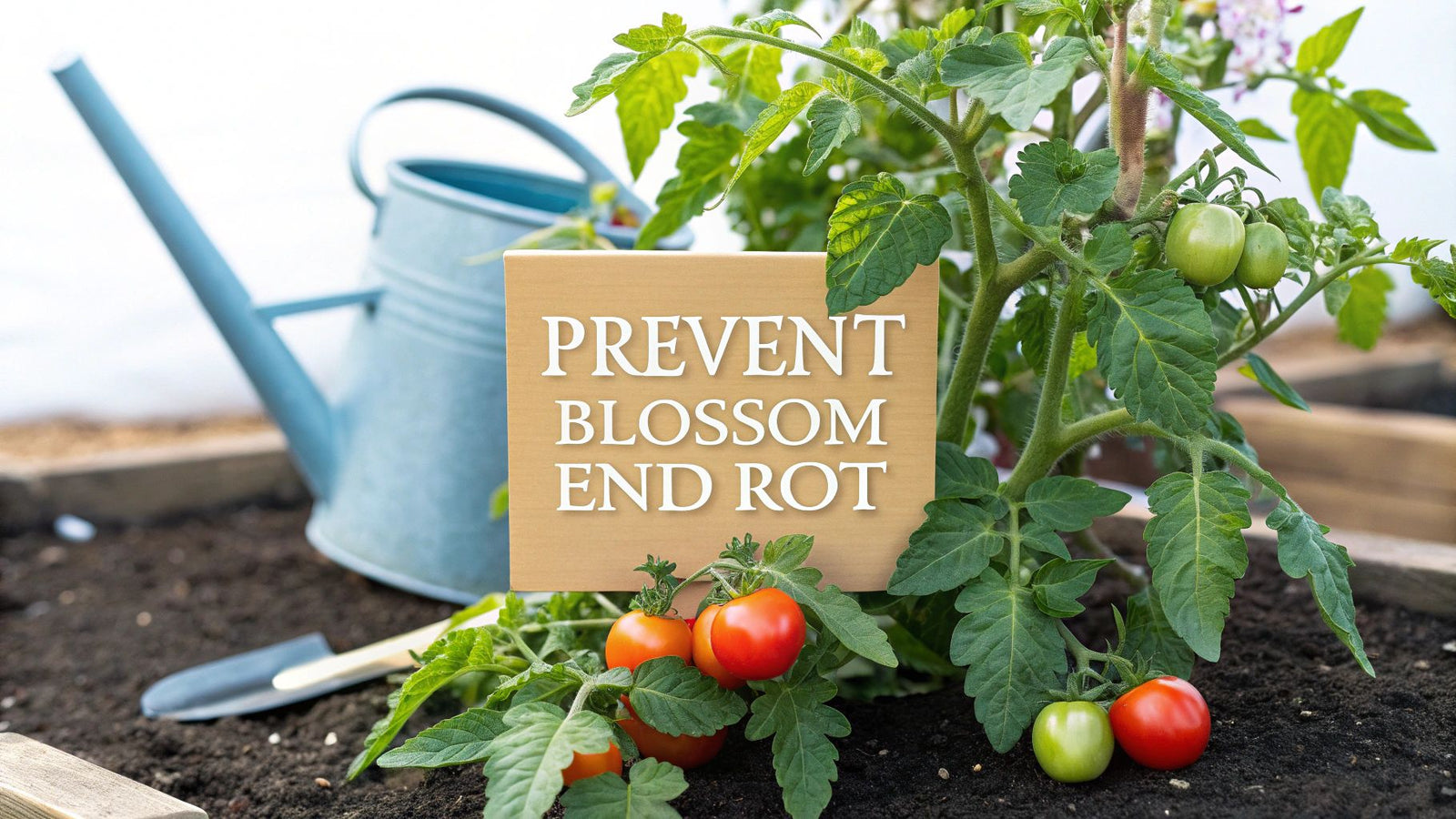
That dark, mushy lesion on the bottom of your ripening tomatoes can be gut-wrenching. It’s not a disease, a fungus, or a pest—it’s a physiological problem called blossom end rot (BER), and it all comes down to a calcium delivery issue inside the plant itself.
The key to stopping it before it starts is creating stability in your garden: think consistent watering, balanced soil nutrients, and avoiding fertilizers that push for explosive, leafy growth at the expense of the fruit.
Getting to the Root Cause of Blossom End Rot
There are few things more frustrating for a gardener than watching a beautiful green tomato develop, only to see that tell-tale dark, leathery patch spread across its bottom. The good news? It won't spread from plant to plant like a disease. The bad news? It means something went wrong with the plant's internal plumbing.
At its core, blossom end rot is a localized calcium deficiency inside the fruit. Calcium is the building block for strong cell walls. As a tomato expands rapidly, it needs a constant, steady stream of calcium ferried up from the roots with water.
If that supply chain gets interrupted, even for a short time, the newly forming cells at the farthest end of the fruit—the blossom end—can't get what they need. They collapse, and that cellular breakdown is what creates the sunken, rotten-looking spot.
The Real Triggers Behind the Calcium Shortage
Most gardeners immediately assume their soil must be low on calcium, but that's rarely the case. More often than not, plenty of calcium is right there in the soil; the plant just can't get it where it needs to go.
Here are the most common culprits that mess up that critical delivery system:
- Inconsistent Watering: This is the number one cause, by far. Letting your soil go from bone-dry to completely saturated is a recipe for disaster. Roots simply can't function properly and pull up nutrients when moisture levels are all over the map.
- Rapid Growth Spurts: Pushing your plants with too much high-nitrogen fertilizer creates a lot of lush, green foliage, fast. This vegetative growth spurt can easily outpace the plant's ability to transport enough calcium into the actual fruit.
- Root Stress: Anything that damages the root system will hobble its ability to absorb water and nutrients. This could be from tilling too close to the plant, pests, or a plant becoming root-bound in a small container.
- Soil pH Imbalance: If your soil is too acidic (or alkaline), calcium can get chemically locked up. Even if there's plenty of it, the plant's roots can't access it.
This isn't a new discovery; scientists have been studying this for over 100 years. Research going all the way back to 1914 has consistently identified this localized calcium shortage as the cause. While over 80% of studies connect BER to a direct deficiency in the fruit, we now understand this happens even in calcium-rich soil when water stress or temperature swings disrupt the transport process.
The most important thing to remember is this: Blossom end rot is less about the amount of calcium in your soil and more about the plant's ability to consistently access and use it. Your best defense is a stable, stress-free growing environment.
If you’re wrestling with persistent plant issues that go beyond simple fixes, sometimes an expert eye can make all the difference. For complex problems, you might consider professional tree care consultations to get a detailed diagnosis and a solid treatment plan.
1. Get Your Watering Right—Consistency is Everything
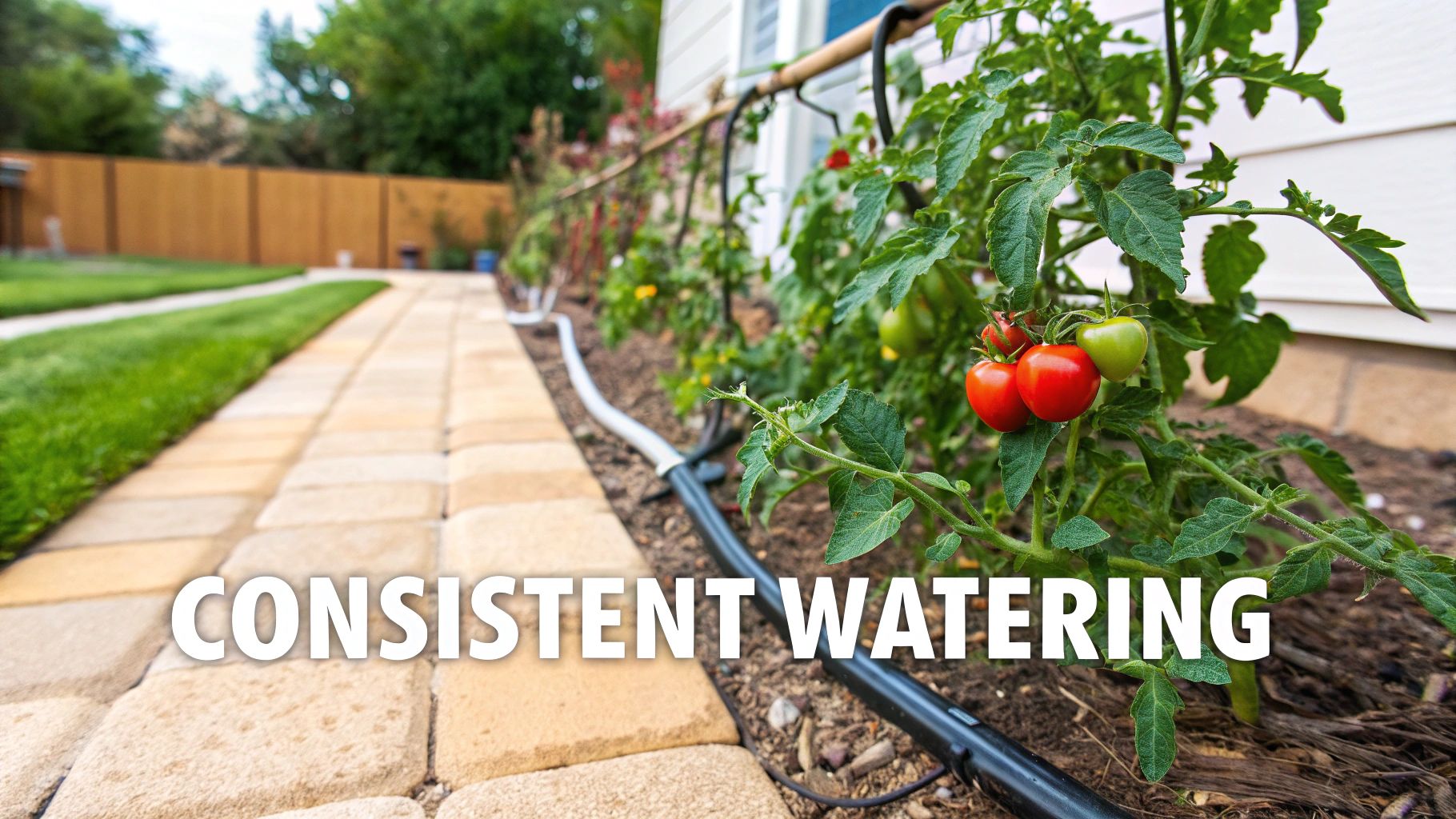
If you take only one piece of advice from this guide, let it be this: consistency in watering is everything. More than any other single factor, going from bone-dry to sopping wet is what triggers blossom end rot. It slams the brakes on a plant's ability to move calcium where it needs to go.
Think of it like this: your plant’s roots are a pump, and that pump needs steady pressure to work. When the soil swings between drought and flood, the system stalls. This is especially true right when plants are flowering and setting fruit, which is their most demanding period for both water and nutrients. One scorching afternoon without water followed by a huge downpour can be all it takes to ruin your beautiful fruit.
The goal isn't just to give your plants a drink, but to maintain a stable, predictable level of moisture deep in the soil.
Set Up a Reliable Watering System
The best way to achieve that consistency is to remove the guesswork. Standing there with a hose is often the least effective method. You lose a ton of water to evaporation, and it encourages shallow roots that are more vulnerable to drying out.
Instead, you want to deliver water directly to the root zone.
- Drip Irrigation: This is my personal favorite. It delivers slow, steady drips right at the base of each plant, pushing moisture deep into the soil where it counts.
- Soaker Hoses: A great alternative, these porous hoses slowly weep water along their entire length, giving a whole garden bed a deep, thorough soaking.
Both of these methods keep the leaves dry, which is a huge bonus for preventing common fungal diseases like blight. They are, without a doubt, the best tools for building the stable moisture foundation your plants need.
Use Mulch as Your Secret Weapon
Once you've delivered that water, you need to keep it there. Applying a 2-3 inch layer of organic mulch is one of the easiest and most impactful things you can do in the garden. It's like putting a protective lid on your soil.
Mulch shades the ground from the intense summer sun, which drastically slows down evaporation and keeps the soil from getting too hot. This is critical—scorched soil stresses roots and makes it even harder for them to absorb nutrients. You can use straw, shredded leaves, or even herbicide-free grass clippings.
University research drives this point home. Studies have repeatedly shown that proper irrigation management is non-negotiable. Consistently moist soil reduced blossom end rot by over 50% compared to plants on an erratic watering schedule. This proves that it doesn't matter how much calcium is in your soil if the plant can't access it due to moisture stress.
That simple layer of mulch also does double duty by suppressing weeds that would otherwise be competing for that precious water and a host of nutrients. If you want to dial in your schedule even further, our guide on the best time to water your vegetable garden will help you maximize absorption and boost plant health.
2. Make Sure Your Soil Has Plenty of Available Calcium
While erratic watering is the number one culprit behind blossom end rot, you can't fix the problem if there's no calcium in the soil to begin with. The best defense is a good offense, and that means setting your soil up for success long before you plant. It's not just about having calcium present; it's about making sure your plants can actually get to it.
Flying blind with your soil is a recipe for frustration. The only way to truly know what you're dealing with is a simple soil test. This isn't just for commercial farmers—it’s a game-changer for home gardeners. A test will show you your nutrient levels and, just as importantly, your soil's pH. You can learn how to test your soil at home and get the data you need to make smart decisions.
A soil test takes the guesswork out of the equation.
Choosing the Right Calcium Amendment
If your test comes back showing a calcium deficiency, don't just run out and grab the first bag you see. Different soil amendments do different jobs, and picking the right one is critical.
- Agricultural Lime: This is your go-to if your soil is both low in calcium and too acidic (low pH). It's a fantastic two-for-one solution that adds calcium while raising the pH to a more plant-friendly level.
- Gypsum: What if your pH is already in the sweet spot but your calcium is low? Gypsum is the answer. It delivers a solid dose of calcium without messing with your soil's acidity.
- Bone Meal: A classic for a reason. Bone meal is a wonderful organic option that provides a slow, steady release of both calcium and phosphorus. I like to mix it directly into the planting hole to give my plants a long-term nutrient source right where they need it.
This chart gives you a quick visual comparison of how much calcium you can expect from each of these common options.
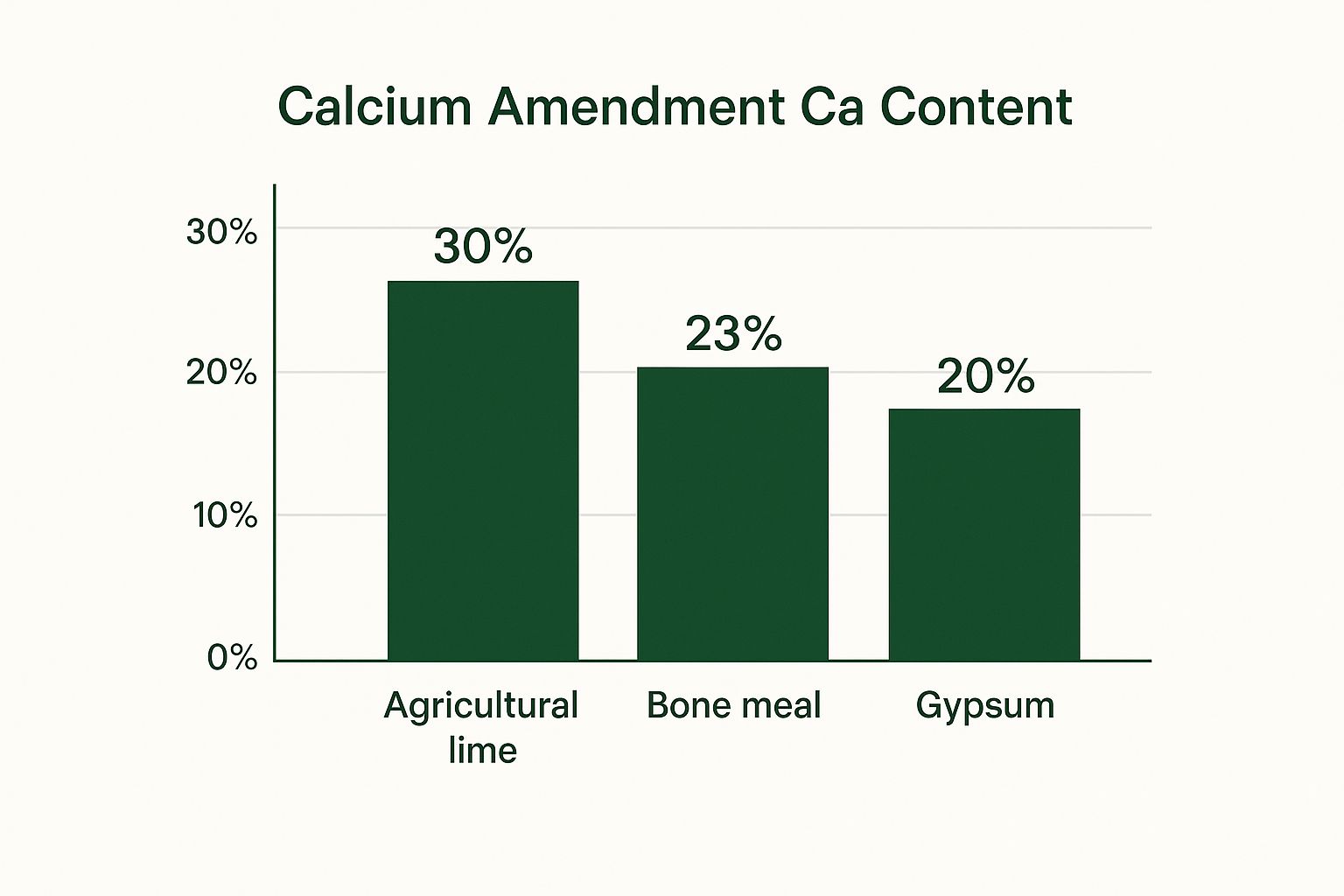
As you can see, agricultural lime packs the biggest calcium punch, making it incredibly effective for soils that need both a nutrient boost and a pH correction.
Why Soil pH Is the Gatekeeper
Think of your soil's pH as the gatekeeper for nutrients. You can have a garden bed loaded with all the calcium in the world, but if the pH is too low (acidic) or too high (alkaline), that calcium gets chemically locked up. Your plants' roots simply can't access it, no matter how much you water.
The magic number for most vegetable gardens, especially for tomatoes and peppers, is a soil pH between 6.0 and 6.8. In this slightly acidic range, calcium stays soluble and available. Keeping your pH in this zone is every bit as important as adding the nutrients themselves.
3. Choose Blossom End Rot Resistant Varieties
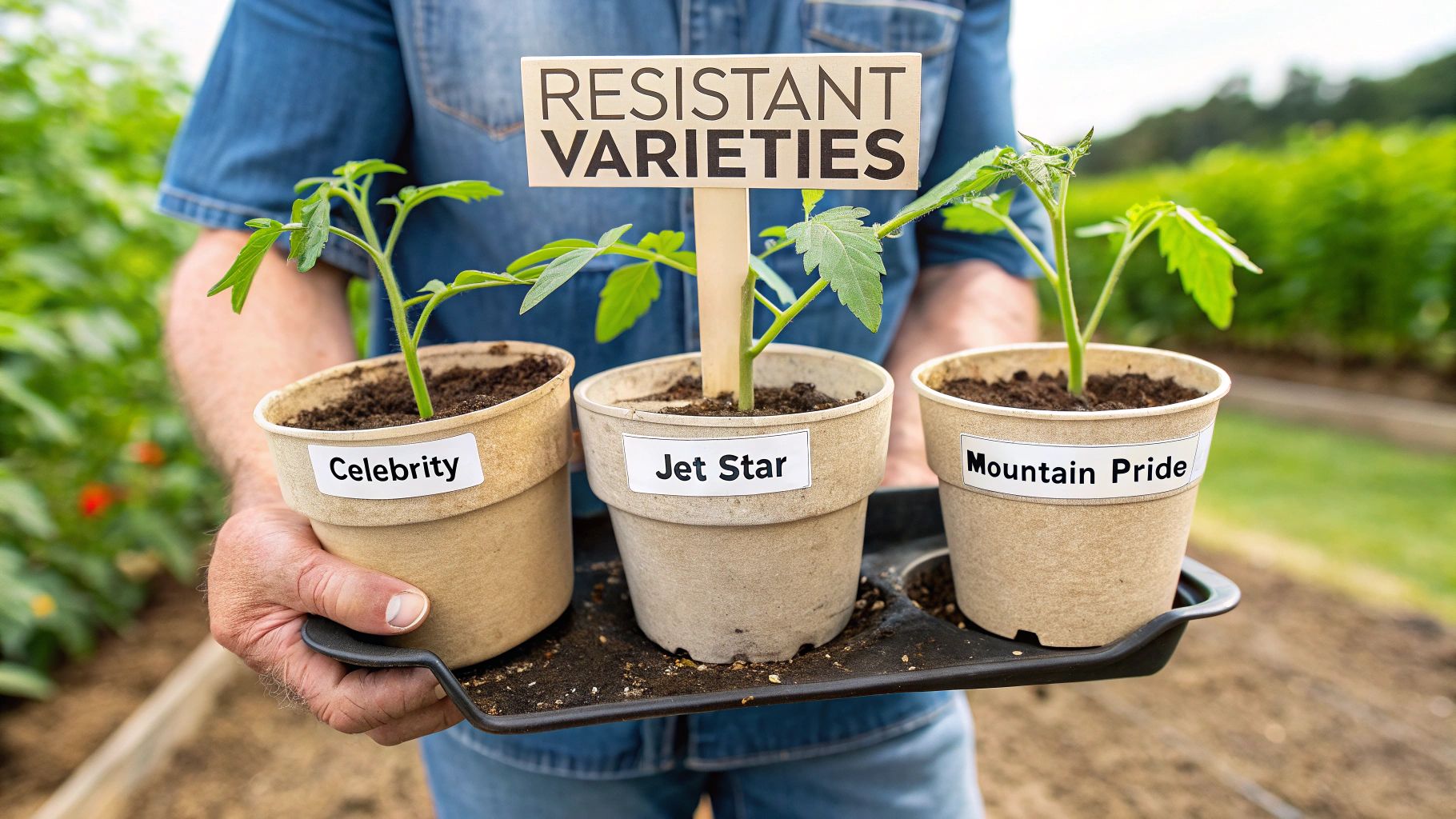
Sometimes the simplest solution is the best one. You can get your watering schedule perfect and amend your soil with care, but if you’re growing a variety that’s prone to blossom end rot, you’re already fighting an uphill battle. Starting with the right plant variety is like giving yourself a head start.
Think about it when you're flipping through seed catalogs or walking the aisles at the nursery. Certain types of tomatoes, especially the long, slender paste varieties like Roma or San Marzano, are notorious for developing that dreaded black spot. Their shape seems to make it more difficult for the plant to push calcium all the way to the blossom end of the fruit.
By deliberately choosing cultivars known for their resilience, you're making a strategic move that can save you a lot of grief later on.
Cultivars That Go the Distance
If you’ve been burned by BER in the past, it’s worth seeking out some of these proven performers. These varieties have earned a reputation for being tough, making them a great bet for gardeners who want to minimize their risk.
- Celebrity: This is a classic, dependable determinate variety for a reason. It produces uniform, crack-resistant slicers and is well-regarded for its overall hardiness.
- Jet Star: A fantastic low-acid hybrid that’s praised for its flavor and its strong resistance to several common tomato diseases, including blossom end rot.
- Mountain Pride: Just like its name suggests, this is a sturdy and reliable plant that can handle less-than-perfect conditions while still producing large, delicious tomatoes.
The link between genetics and BER isn't just a gardener's tale; it's a scientific fact. In studies where different cultivars were grown under the same conditions, the incidence of BER ranged from as low as 7.1% to over 22%. The only difference was the plant's genetics. This is solid proof that some varieties are just better built to manage the stresses that cause this disorder. For a deeper dive, you can explore the cultivar-specific findings from this research.
A Proactive Approach: While no tomato plant is completely immune, selecting a resistant variety is one of the most effective proactive steps you can take. It shifts the odds dramatically in your favor before you even put a shovel in the ground.
A Quick Guide to Tomato Varieties and BER
To help you choose, I've put together a quick comparison of some popular tomato cultivars and their general susceptibility to blossom end rot. This isn't an exhaustive list, but it's a great starting point for planning your garden.
Blossom End Rot Susceptibility in Common Tomato Cultivars
| Cultivar Name | Susceptibility Level | Primary Use (Slicing, Sauce, etc.) |
|---|---|---|
| Celebrity | Low | Slicing, All-Purpose |
| Jet Star | Low | Slicing, Sandwiches |
| Mountain Pride | Low | Slicing |
| Better Boy | Low-Moderate | Slicing, All-Purpose |
| Early Girl | Moderate | Slicing, Early Harvest |
| Roma | High | Sauce, Paste |
| San Marzano | High | Sauce, Canning |
| Amish Paste | High | Sauce, Paste |
Remember, even a "High" susceptibility variety can be grown successfully with careful water and nutrient management. But if you're looking for a lower-maintenance and more forgiving experience, choosing a variety from the "Low" end of the spectrum is a smart move.
4. Don't Go Overboard with High-Nitrogen Fertilizers
When you're trying to get the biggest harvest, it's tempting to think more fertilizer is the answer. But with blossom end rot, it’s not about how much fertilizer you use, but what kind. Dousing your plants in high-nitrogen food can actually do more harm than good.
Nitrogen is what gives you those beautiful, lush green leaves. The trouble is, it sends the plant into overdrive, pushing out tons of new foliage. This growth spurt creates a sudden, massive demand for calcium that the roots just can’t meet, leaving the developing fruit to starve.
Getting the Fertilizer Ratios Right
The secret is to pay attention to the three numbers on your fertilizer bag—the N-P-K ratio. These numbers tell you the percentage of Nitrogen (N), Phosphorus (P), and Potassium (K), always in that specific order.
Here’s a quick breakdown of what those numbers mean for your garden:
- High-Nitrogen: A bag showing a ratio like 24-8-16 is all about leafy growth. It’s exactly what you don't want for your fruiting plants.
- Balanced: Something closer to 10-10-10 offers an even mix of nutrients for general plant health.
- Low-Nitrogen: A formula like 5-10-10 is the sweet spot. It dials back the nitrogen and puts the focus on phosphorus and potassium to support strong roots and healthy fruit.
For your tomatoes, peppers, and squash, stick with a balanced or low-nitrogen formula made for vegetables. This approach ensures they get a steady supply of nutrients without that explosive foliage growth that messes with calcium delivery. For more detailed advice, check out our complete guide to the best fertilizer for tomatoes and peppers.
The goal is to feed for fruit, not just for a jungle of leaves. A super bushy, green plant that can't get enough calcium to its tomatoes is a classic setup for blossom end rot.
A fantastic—and much simpler—organic option is to just work some well-rotted compost into your soil. Compost is a natural slow-release fertilizer, giving your plants a balanced diet without ever overwhelming them. It also improves your soil's ability to hold water and supports the kind of steady, healthy growth that leads to a rot-free harvest.
5. Protect Plant Roots and Manage Soil Health
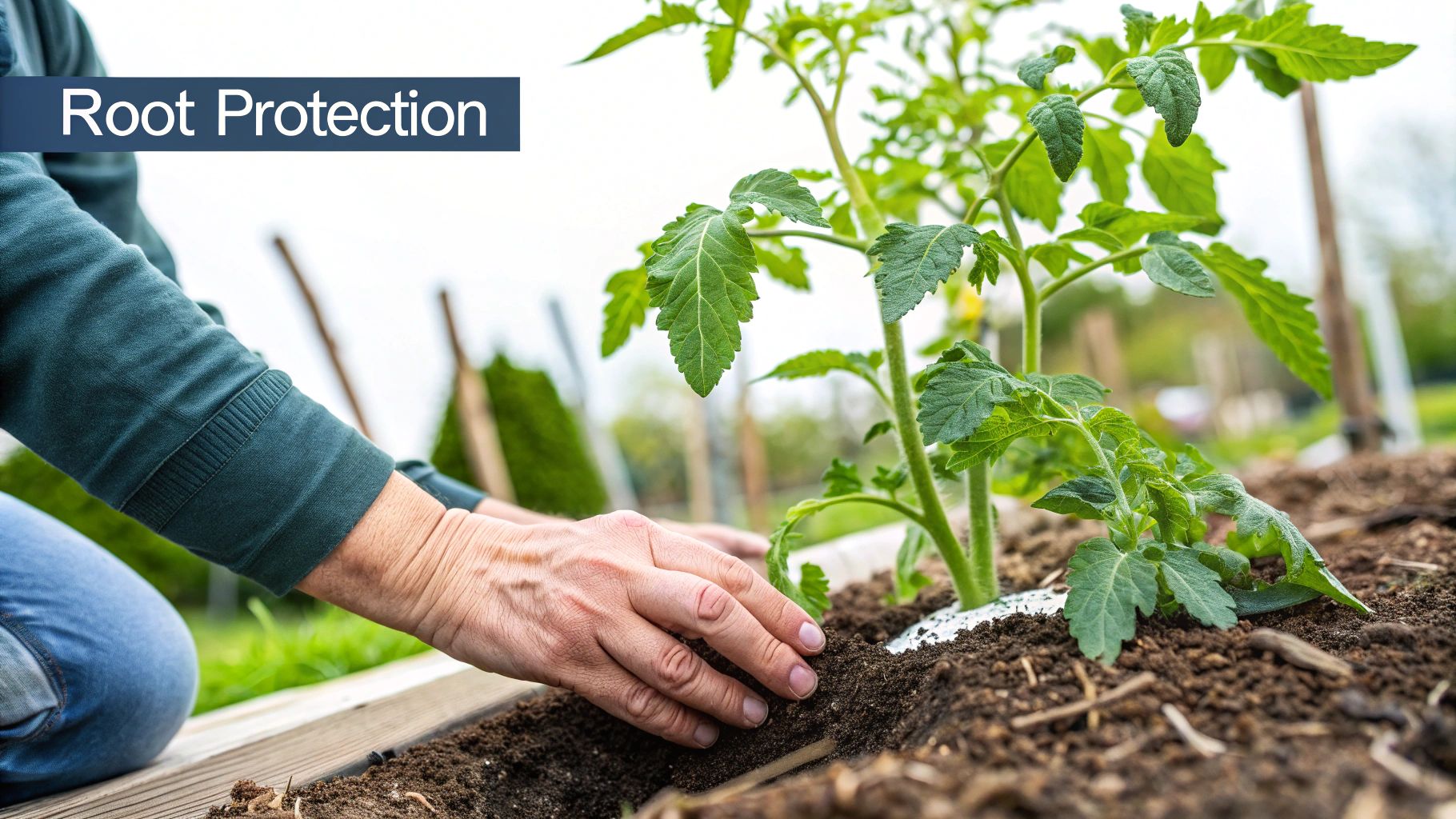
Think of a plant's root system as its lifeline. It’s the intricate network that pulls up every drop of water and every bit of nutrition needed to form those perfect, blemish-free fruits. If you damage this delicate system, you're essentially cutting off the plant's supply line.
This is a huge, often overlooked, cause of blossom end rot. Even with perfect soil and a consistent watering schedule, a plant with damaged roots simply can't absorb the calcium it needs.
Protecting these roots starts with how you work around your plants. When you’re weeding or tilling the soil, stay mindful. Be gentle and work a good few inches away from the plant stem. It’s all too easy to nick shallow feeder roots with a hoe, which immediately stresses the plant and slams the brakes on nutrient uptake.
Proper spacing is another key piece of the puzzle. It's not just about giving leaves room for sunlight—it's about giving roots enough territory to expand without a turf war. Crowded plants are forced to compete for the same pocket of water and nutrients, meaning someone always loses out.
Container Gardening Considerations
Growing in containers gives you incredible control, but it also presents a unique challenge for root health. The number one mistake I see is gardeners using pots that are just too small.
As the plant grows, its roots inevitably hit the walls of the container and start to circle, becoming root-bound.
A tangled, root-bound mass can't absorb water and nutrients efficiently. There’s simply no new soil for the roots to explore. This situation creates a perfect storm for blossom end rot, even if you're watering daily.
The 5-Gallon Rule: I tell every gardener the same thing: a single tomato plant needs at least a 5-gallon container. This isn't just a suggestion; it's a baseline for success. A pot this size gives the root system the room it needs to grow strong and access moisture consistently all season long.
Practical Tips for Root Health
To build a strong foundation for your plants and avoid the root stress that triggers BER, keep these simple tips in mind:
- Handle with Care: When moving seedlings into the garden, be as gentle as possible with the root ball. The less you disturb it, the less transplant shock you'll have.
- Give Them Space: Pay attention to the spacing guidelines on your seed packets. For most tomato varieties, that means giving them at least 24-36 inches of breathing room from their neighbors.
- Go Big on Pots: If you're using containers, always err on the side of a larger pot. More soil means better moisture retention and happier, more expansive roots.
Ultimately, a healthy root system is non-negotiable for preventing blossom end rot. If you treat the hidden half of your plant with as much care as the leaves and fruit, you'll be setting yourself up for a fantastic harvest.
6. Know Your Enemy: FAQ on Blossom End Rot
Even after you’ve done everything right, you might still have some questions when you spot that dreaded dark spot on your tomatoes. It happens to the best of us. Let's tackle some of the most common things gardeners wonder about blossom end rot so you can handle it like a pro.
Can I Still Eat Fruit with Blossom End Rot?
Yes, you absolutely can. It's a huge relief to know that blossom end rot isn't some kind of disease or rot that ruins the whole fruit. It’s simply a localized spot where the tissue broke down because it couldn't get enough calcium.
The rest of the tomato, pepper, or squash is perfectly fine. Just grab a knife, slice off the dark, leathery patch, and the rest is good to go for your salads, sauces, or sandwiches.
Are Calcium Sprays a Quick Fix?
I see these products everywhere, and they're often sold as a silver bullet for blossom end rot. The truth is, they're mostly a waste of money. A plant's plumbing is designed to draw calcium up from the roots, not absorb it through the leaves or fruit skin.
Trying to fix blossom end rot with a foliar spray is like trying to quench your thirst by spritzing your face with water. It doesn't solve the core problem, which is almost always about inconsistent watering preventing calcium from reaching the fruit in the first place.
Your energy is much better spent on improving your soil, maintaining consistent moisture, and applying a good layer of mulch. That’s the real long-term fix.
Is Blossom End Rot Contagious?
This is a big one, and the answer is a firm no. It's a physiological disorder, not a disease caused by a fungus, bacterium, or virus. It cannot spread from one fruit to another or from one plant to its neighbor.
If you see it popping up on several plants at once, don't panic and think you have an epidemic on your hands. Instead, see it as a sign. It’s your garden telling you that there's a bigger environmental issue at play—likely a recent heatwave that dried things out, a period where your watering was off, or a broader soil imbalance that needs your attention.
At Homegrown Garden, we believe a thriving garden is built on great seeds and solid know-how. Check out our collection of heirloom seeds, handy gardening kits, and expert guides to grow your best harvest yet. Find everything you need at https://www.homegrown-garden.com.



